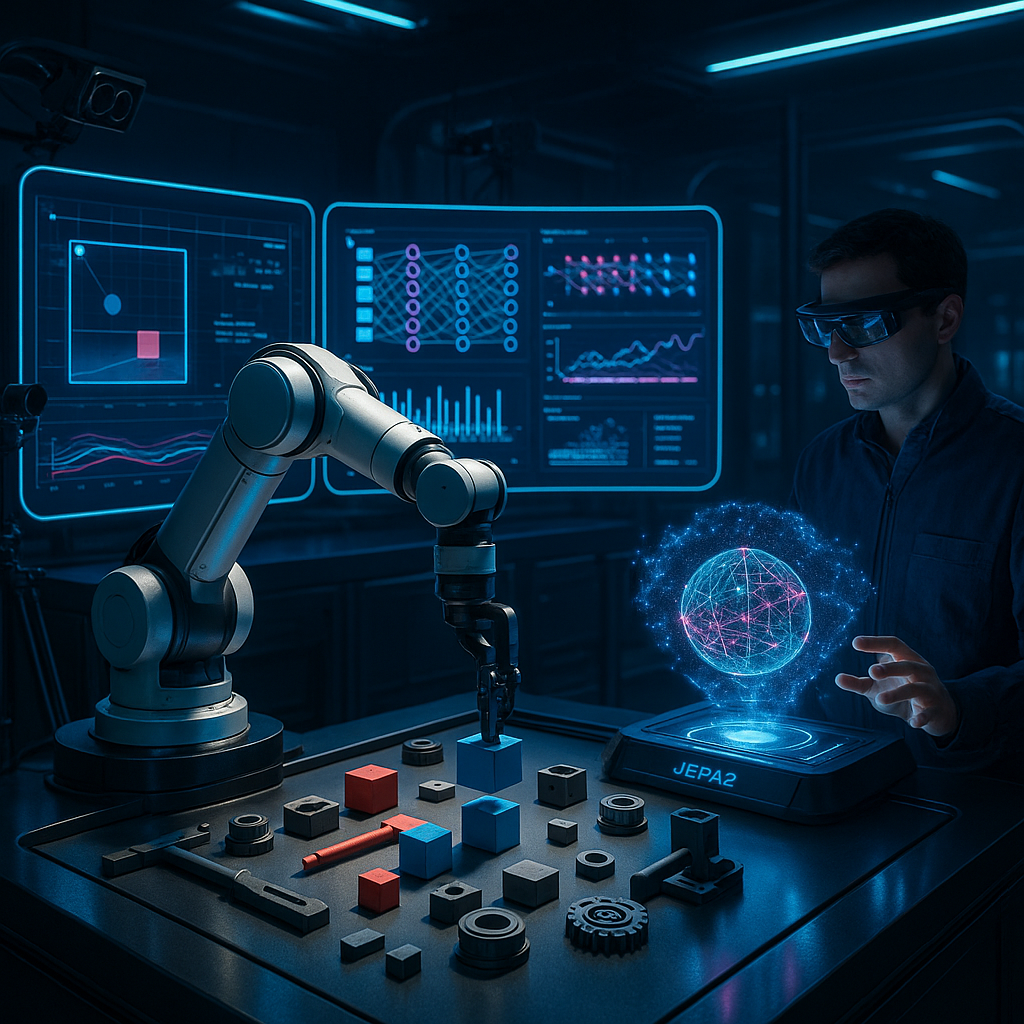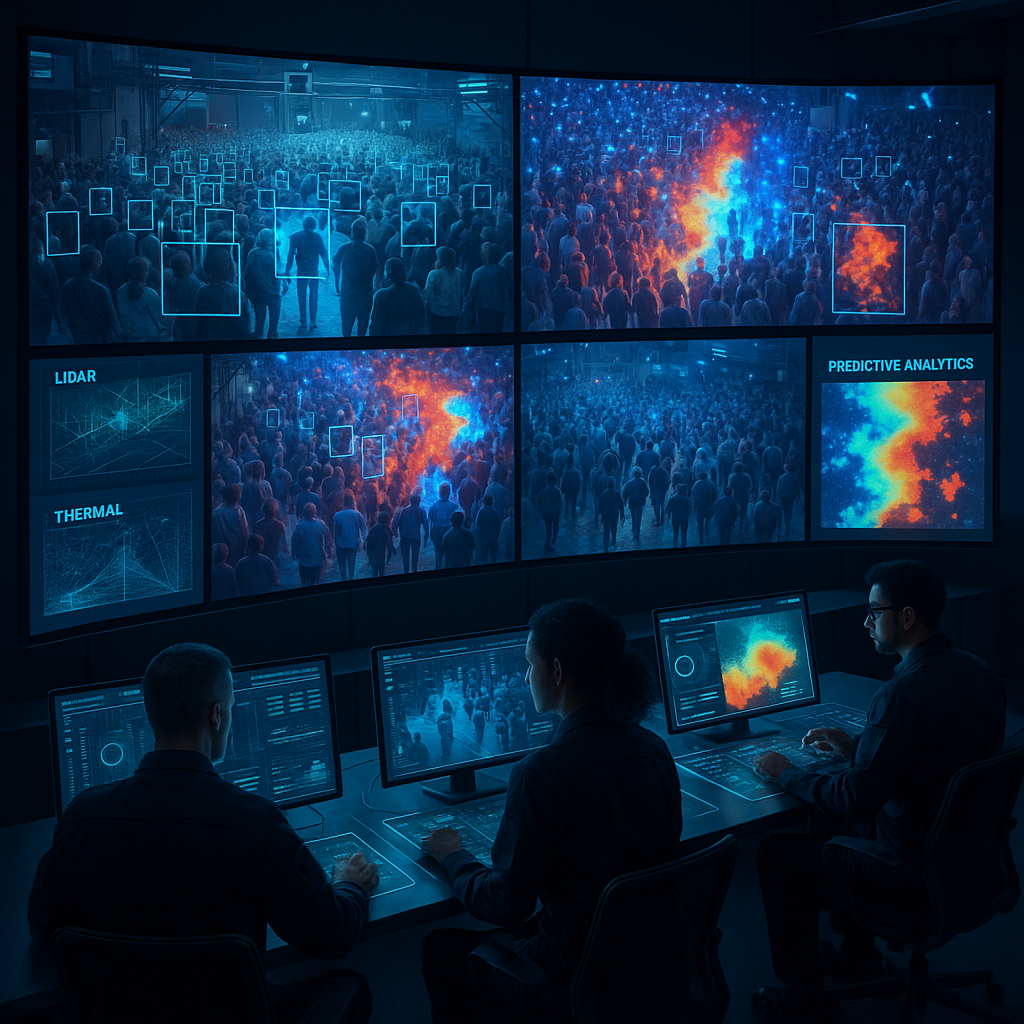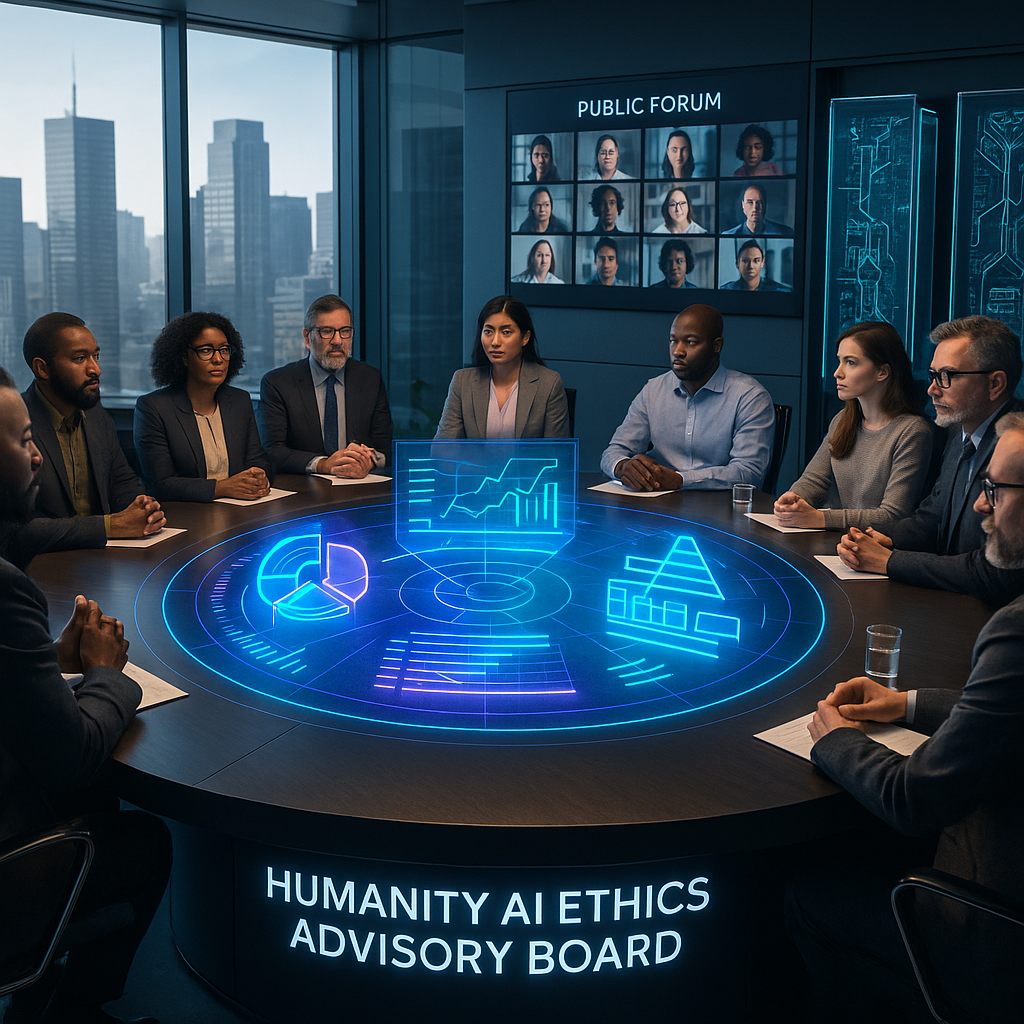Key Takeaways
-
From Words to Worlds: AI Expands Beyond Language
World models, in contrast to language models, predict real-world physics, causes, and actions. This enables AI not just to parse information, but to intuitively understand and interact with its environment in complex, dynamic ways. -
JEPA2 Breaks the Language Barrier with Multimodal Learning
The Joint Embedding Predictive Architecture 2 (JEPA2) system learns from rich patterns in visual, spatial, and sequential data (including text, images, and movement), unlocking broader, more versatile cognition that surpasses the limitations of purely language-based AI. -
Self-Improvement Drives Exponential AI Progress
Leveraging self-supervised learning, advanced world models like JEPA2 continuously refine predictions and adapt to novel environments. This capacity for self-improvement accelerates the path toward more general intelligence, untethering AI from the boundaries of preprogrammed behavior. -
Applications Leap from Screens to the Physical World
World models enable breakthroughs across domains: robotics (grasping, manipulation, and navigation), autonomous vehicles (real-time environmental reasoning), healthcare (intelligent diagnostics and adaptive interventions), finance (market scenario simulation), education (interactive learning agents), and virtual agents that operate and react in real-time physical or simulated environments. -
Foundation Models Lay the Groundwork for Embodied Intelligence
By integrating perception, prediction, and action into a unified architecture, world models provide the scaffolding for AI that understands the “rules of the game” in reality. This development propels artificial agents closer to the threshold of general intelligence with applications that mirror human adaptability. -
A Paradigm Shift: From Token Prediction to Real-World Reasoning
AI is evolving from clever dialogue engines into agents capable of genuine reasoning and decision-making based on physical laws. This transition, as radical as humanity’s discovery of fire, reimagines the promise of AI on a global scale.
As we move beyond the realm of words into the intricate tapestry of the physical world, the rise of foundation models like JEPA2 signals not merely better machines, but a fundamental transformation in how we conceive of intelligence. No longer just spoken or written, but lived, enacted, and experienced. With this leap, the story of AI begins to bind itself directly to the realities we inhabit. Let us examine how these architectures are poised to redefine what it means to think, to learn, and even to be.
Introduction
Imagine a world in which machines do not merely converse, but sense, anticipate, and act in accordance with the logic that underpins our universe. This is the promise unfolding with foundation world models like JEPA2. It marks a leap beyond the clever wordplay of language models and into the embodied realities of perception, causality, and prediction.
The significance of this shift extends well beyond chatbots or semantic search. World models such as JEPA2 are not passive processors of information; they inhabit it, using self-supervised learning and immersive engagement with vast, unlabeled data to adapt and grow. Through such architectures, AI takes a bold step toward bridging the gap to general intelligence. In the process, entire industries—from robotics to healthcare, education, engineering, and more—are being reimagined. Let’s explore how this new generation of AI systems is transforming not only our tools but our very conception of intelligence itself.
The Evolution from Language Models to World Models
The trajectory from language models to world models marks a defining transformation in artificial intelligence. Traditional language models, such as large language models (LLMs), excel at processing and generating text with remarkable fluency, yet they operate in a symbolic domain disconnected from physical experience. They can mimic understanding but cannot truly grasp the laws that govern events in the real world.
Stay Sharp. Stay Ahead.
Join our Telegram Channel for exclusive content, real insights,
engage with us and other members and get access to
insider updates, early news and top insights.
 Join the Channel
Join the Channel
This gap is what world models strive to bridge. Rather than simply correlating sequence patterns, they develop internal representations of objects, forces, and interactions encountered within physical or simulated environments. Much as humans learn about their surroundings through touch, sight, and experience, these models absorb vast streams of sensory information (visual, auditory, spatial) to build an intuition for how the world works.
By simulating reality, world models foster a form of intelligence that more closely mirrors human development. Their predictions are grounded not only in what “should” come next in a sentence, but in what “happens” next in the real world, whether that’s a ball rolling down a hill, a chemical reaction unfolding, or a robot navigating obstacle-laden terrain.
Understanding JEPA2’s Revolutionary Approach
JEPA2 stands at the vanguard of world model development, advancing AI’s capabilities from mere language prediction to genuine physical and causal understanding. Its architecture reimagines how machines perceive and interact with data.
Core Architectural Components
JEPA2 achieves its unique capabilities through a sophisticated joint embedding space, where multi-modal data (visual, spatial, sequential, and linguistic) are encoded into a shared representational framework. This design empowers the model to:
- Abstract and compress diverse sensory scenes into meaningful representations
- Anticipate the outcomes and transitions of physical interactions
- Learn entirely from unlabeled, real-world data streams via self-supervised learning mechanisms
- Generate realistic, dynamic predictions for scenarios never before encountered
This embedding strategy allows JEPA2 to move past pattern recognition into the realm of causality, discerning invariant principles and relationships that remain constant across changing environments. The result is an AI system that can generalize learned knowledge far beyond its initial training context.
The Physics-First Paradigm Shift
Moving from linguistic to physics-first analytics, world models introduce a radical new mode of machine learning. Instead of stringing words together based on statistical likelihood, these models develop a grasp of the forces, constraints, and probabilistic outcomes of real-world events.
From Tokens to Physical Understanding
This evolutionary leap manifests in critical ways across different sectors:
- Predictive Power: World models forecast outcomes not just in text but in time and space, allowing for prediction of object trajectories, biochemical reactions, financial market shifts, or patient health scenarios.
- Causal Understanding: By inferring causal structures from raw data, these models distinguish genuine causation from mere correlation (vital for diagnostics in healthcare, risk assessment in finance, or process optimization in manufacturing).
- Embodied Knowledge: Through continuous observation and interaction, world models internalize knowledge akin to experiential learning, much like a child gains understanding from manipulating and observing their environment.
This approach, reminiscent of the way biological intelligence emerges, opens doors to more resilient, adaptable, and intuitive AI. Suitable not just for digital tasks, but for real-world problem solving, too.
Applications and Real-World Impact
The influence of world models reverberates across a broad spectrum of industries, far transcending the boundaries of language-centric AI. By incorporating multi-modal learning and physical prediction, these models are rapidly closing the gap between simulated intelligence and tangible action.
Robotics and Automation
- Precision Motion Planning: Robots equipped with world models can anticipate the impact of their actions, resulting in more accurate and flexible object manipulation, assembly, and logistics operations.
- Adaptive Navigation: Such models enhance autonomous drones and vehicles, enabling seamless movement through unpredictable, changing environments.
- Human-Robot Interaction: Predictive modeling enables smoother, safer collaboration between humans and machines on factory floors and in medical settings.
Scientific Discovery
- Complex System Simulation: JEPA2-powered models can replicate intricate physical, chemical, or ecological processes, fostering breakthroughs in climate studies, drug discovery, and materials science.
- Data-Driven Hypothesis Generation: These tools expedite scientific research by revealing patterns and causal relationships in massive, multidimensional datasets.
Healthcare
- Diagnostic Enhancement: Predictive modeling of patient outcomes allows for earlier detection of disease progression and more tailored intervention strategies.
- Intelligent Medical Robotics: Robots can perform delicate procedures and adapt to real-time physiological changes, speeding adoption in operating rooms and eldercare facilities.
Finance
- Scenario Forecasting: World models simulate complex market dynamics and economic scenarios, aiding better risk analysis, fraud detection, and portfolio management.
- Algorithmic Trading: These systems adapt to evolving market rhythms, allowing institutions to operate with increased agility and predictive power.
Education
- Personalized Learning Agents: AI tutors model student progress, dynamically adapting instruction for optimal learning outcomes.
- Physics-Based Training Simulators: Immersive environments help students learn through interactive experimentation with real-world principles.
Legal & Compliance
- Automated Contract Analysis: Predictive models simulate contractual obligations and forecast potential legal pitfalls.
- Compliance Monitoring: These systems anticipate regulatory risks by modeling organizational and market behaviors.
Environmental Science
- Resource Allocation & Climate Modeling: World models forecast resource needs and environmental impact, supporting more effective sustainability initiatives.
Consumer Technology
- Smart Virtual Assistants: Devices that proactively adapt to user routines, predicting needs before they are articulated.
- Personalized Product Recommendations: AI adjusts suggestions based on predictive modeling of user behavior in shopping and digital environments.
Challenges and Future Directions
As world models rise in prominence, they bring formidable technical and theoretical challenges that must be met before their full potential can be realized.
Technical Hurdles
- Computational Complexity: Accurately simulating nuanced physical environments at scale demands enormous computational resources and refined algorithms.
- Generalization and Scalability: Extending learned knowledge from simple environments to the chaotic complexity of real-world contexts (such as bustling city streets or heterogeneous biological systems) remains a significant challenge.
- Data Diversity and Quality: High-quality sensor data across numerous environments is necessary to train robust, generalizable models.
Theoretical Considerations
- Linking Learned Models to Explicit Laws: Developing ways to confirm that a model’s predictions faithfully represent underlying physical principles, and not just data artifacts.
- Understanding Abstraction Levels: Determining how abstracted a model’s representations should be for each application to strike a balance between efficiency and interpretability.
- Bias and Interpretability: Ensuring models are transparent, fair, and ethical, especially in high-impact sectors like healthcare or criminal justice.
Ongoing research must address these barriers, pairing computational advances with rigorous interdisciplinary oversight.
The Path to General Intelligence
The world model paradigm may represent our most promising approach yet to artificial general intelligence. By rooting machine learning in the invariant rules and causal networks that undergird reality, world models equip AI with faculties once thought uniquely human: true abstraction, intuitive reasoning, and the ability to generalize knowledge across domains.
Key Advantages for AGI Development
- Reality-Grounded Understanding: Mastery of physical and causal principles allows for common-sense reasoning and planning.
- Cross-Domain Adaptability: Physics-driven learning equips agents to tackle a diverse array of problems in fields as disparate as engineering, medicine, and environmental management.
- Intuitive Cause-and-Effect Reasoning: Instead of mere pattern matching, these models make inferences based on underlying dynamics, crucial for robust decision-making under uncertainty.
- Embodied, Adaptive Intelligence: Through ongoing interaction with the environment, world models evolve, mirroring the resilience and flexibility of living systems.
While challenges remain, this avenue of research may ultimately enable the creation of AI systems that participate alongside humans, not only as tools but as collaborative agents in discovery, design, and problem solving.
Conclusion
The rise of world models like JEPA2 signals a watershed moment in the evolution of artificial intelligence. For the first time, machines are being equipped with the faculties required not just to parse or predict language, but to understand and navigate the physical rules that define our universe. By embedding the logic of physics and causality into their core architectures, these new systems are setting the stage for a generation of AI capable of genuine insight, interaction, and creative adaptation across diverse fields.
Already, applications in robotics, healthcare, finance, engineering, and the sciences are being redefined, as machines gain the ability to anticipate, plan, and act with an unprecedented degree of autonomy and context-awareness. Yet the journey ahead is filled with formidable questions. How do we marry computational accuracy with interpretability and ethics? In what ways might these alien intelligences challenge our own assumptions about knowledge, agency, and learning?
As the frontiers of artificial intelligence extend beyond the constraints of language and programming, the ultimate challenge no longer centers on whether machines can match human intelligence, but whether we can guide these new forms of mind to augment our world responsibly, transparently, and for the benefit of all. In a future shaped by embodied AI, the most compelling opportunities (and the most profound dilemmas) will belong to those who ask not just what we can build, but what we are becoming. The question before us is not whether to embrace these emerging possibilities, but how boldly and wisely we shape their impact on the world we share.
Stay Sharp. Stay Ahead.
Join our Telegram Channel for exclusive content, real insights,
engage with us and other members and get access to
insider updates, early news and top insights.
 Join the Channel
Join the Channel





Leave a Reply